|

On eBay Now...
WWII US A2 Flight Jacket Lt ALLEN BENNETT 49th Figher Group "Screamin' Demons" For Sale
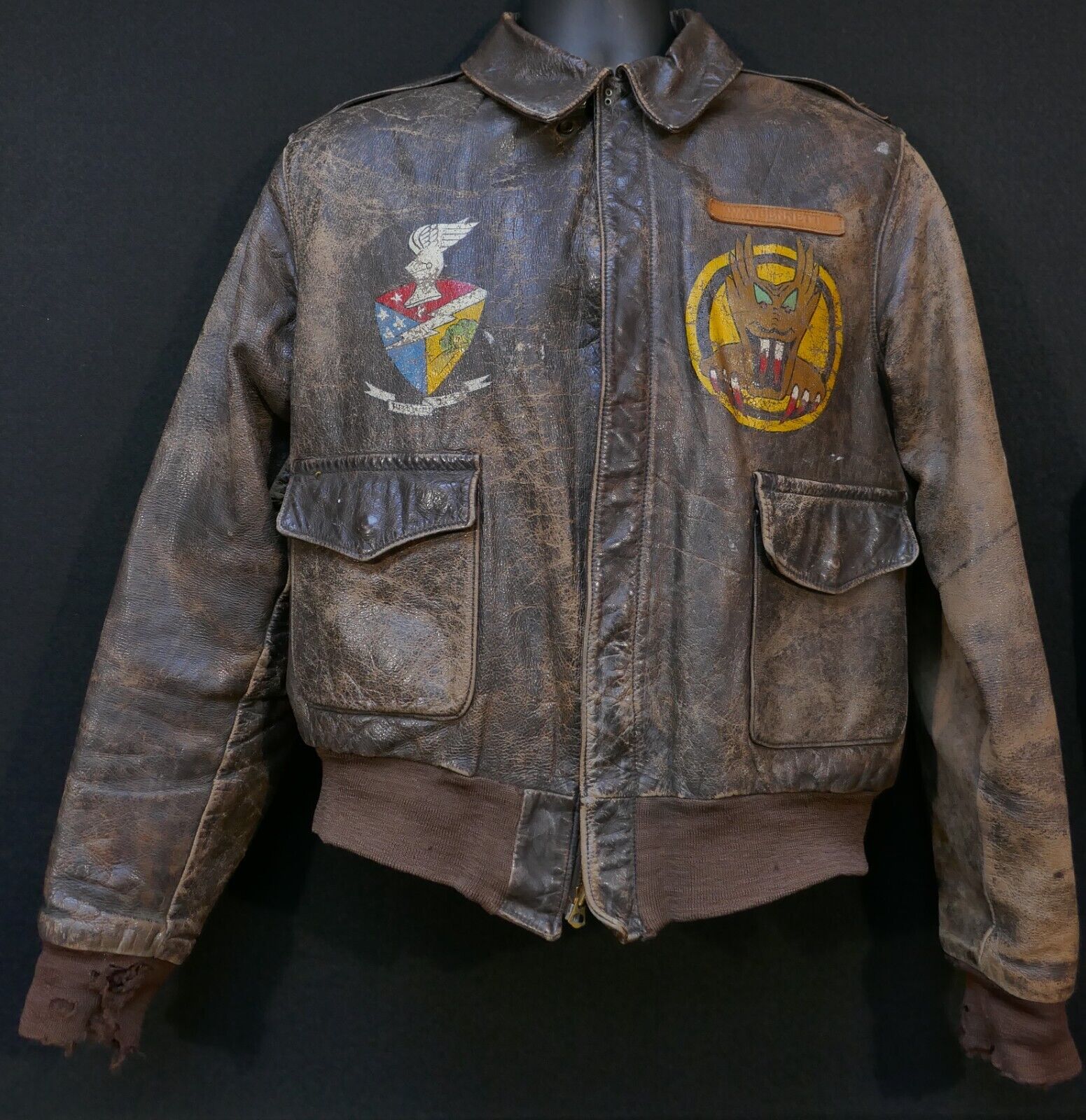
When you click on links to various merchants on this site and make a purchase, this can result in this site earning a commission. Affiliate programs and affiliations include, but are not limited to, the eBay Partner Network.

WWII US A2 Flight Jacket Lt ALLEN BENNETT 49th Figher Group "Screamin' Demons":
$2589.30
WWII US A2 Pilot Flight JacketWWII US A2 Flight Jacket Lt ALLEN BENNETT 49th Figher Group "Screamin' Demons" Rare Original Artefact P-40 Kittyhawk Pilot - Unit History The 49'ers started as the 49th Pursuit Group in the Army Air Corps when Major Glen Davasher took command of the newly formed group on 20 November 1940 at Selfridge airfield in Michigan, USA. It was formed from parts of the 94th Pursuit Group. The 31st Pursuit group was established at Selfridge at the same time. The three flying Squadrons of the original World War Two 49th Pursuit Group were:-7th Squadron "Screamin' Demons"-8th Squadron "Blacksheep" -9th Squadron "Flying Knights" -Major Davasher collapsed from the Flu in February 1941 and command of the 49'ers was handed over to Major John Egan. His time as Commanding Officer was short lived. In May 1941 Major George "Snuffy" McCoy was placed in charge of the 49'ers.On 16 May 1941 the 49th Pursuit Group relocated in 75 trucks to their new home base at Morrison airfield at West Palm Beach. It was a 4 day, 1100 mile journey.In readiness for their new aircraft, the Squadron Commanders positions were filled as follows:- Headquarters Squadron Captain Don Hutchinson 7th Squadron Lieutenant Allen Bennett 8th Squadron Lieutenant Robert Van Auken 9th Squadron Captain Victor Pixey 49th Interceptor Squadron (radiomen) Lieutenant Robert Van Auken On 20 June 1941, the 49th Pursuit Group was attached to the 3rd Air Force whose headquarters were at Drew airfield in Florida.Each Squadron received one PT-17 Stearman, one PT-13 Ryan Basic Trainer, three P-35 Seversky Advanced Trainer fighter aircraft and one P-40C Curtiss Warhawk for training purposes.On 20 September 1941, 2nd Lieutenant Caryle Loverud was killed when the engine in his P-35 seized and crashed near Jackson in Georgia.In December 1941, Lieutenant Howard Cory died when his Curtiss fighter struck a fog covered hill as he approached St. Louis during a very long cross-country flight.At Christmas time, orders were received for the 49th Pursuit Group to mobilise.Lieutenant Morrissey replaced Bennett as CO of the 7th Squadron. Lieutenant Jim Selman took over command of the 9th Squadron from Captain Pixey. Lieutenant George Powell took over command of the radiomen of the 49th Interceptor Squadron.On 4 January 1942, the 49'ers boarded trains and set out for California, arriving in San Francisco on 8 January 1942. They stayed in the County Livestock Pavilion, affectionately known as the "Cow Palace". While in San Francisco they signed on 75 new pilots and 587 more enlisted men.Embarkment orders were issued on 10 January 1942 and on 12 January 1942 they headed by truck to the Matson Ship Line docks. The majority of the 49'ers boarded the USAAT Mariposa and the remainder boarded the USAT Coolidge.The 808th Engineer Aviation Battalion was also on board the President Coolidge. Their heavy equipment was on the freighter "Luckenbach".By mid afternoon, the Mariposa and the President Cooldige along with the USAAT Monroe, were escorted by the light cruiser USS Phoenix under the Golden Gate bridge headed for the Pacific Ocean. They mostly thought that their destination was a base in the southern Philippine Islands. On 24 January 1942, the Mariposa's steering became faulty. After quick repairs she was under way again and caught up with the rest of the convoy. The steering went faulty again on 27 January 1942.
On 27 January 1942 the USAAT Monroe left the convoy and was escorted to its destination by two British Royal Navy escort destroyers.
On 28 January 1942, the ship's captain advised Major Wurtsmith that their course had been changed and their new destination was Melbourne, Australia. On 31 January 1942, the convoy sighted the Australian coastline at Cape Howes. As they travelled south along the coastline they could see the blue outline of the Snowy Mountains. On 1 February 1942, after passing Wilson's Promontory, their escort, the USS Phoenix, left them and they were joined by two tug boats to escort them into Port Phillip Bay in Melbourne. They anchored and slept on board that night.The first groups of the 49th Pursuit Group left their ship on 2 February 1942. They caught buses to Flinders Street railway station in Melbourne where they boarded trains for a variety of different military and civilian sites around Melbourne including Camp Darley. Some had to bivouac in the open in tents, while some others were lucky to be sleeping in tin sheds.Major Wurtsmith departed in a staff car to report to the Deputy Chief of Air Staff for the RAAF, Commodore F.M. Bladin. Wurtsmith was advised of his promotion to Lieutenant Colonel. His deputy, Hutchinson was promoted to Major. All of the Squadron CO's were made Captains. Captain Powell was moved to HQ staff and 2nd Lieutenant Bill Ladendorf was then put in charge of the 49th Interceptor Controllers.Back at the wharf, the Australian wharfies had refused to unload the munitions. Over 100 men of the 49th then started to unload the two ships over the next 3 days.The 49th Pursuit Group was the first American unit to arrive in Australia as a complete unit, with all flying and support echelons fully manned and equipped.Fighter aircraft and light bombers, originally destined for the Philippines were diverted to Brisbane and Townsville. Once assembled they would be flown west for the journey to Darwin (Base One). From Brisbane they would fly 400 miles due west to Charleville. Then a further 550 miles to Cloncurry, still in Queensland. Aircraft assembled in Townsville would fly 400 miles directly to Cloncurry. The next leg was a 500 mile hop to Daly Waters in the Northern Territory and then finally the leg to Darwin.This route was part of what was known as the "Brereton Route" from Brisbane to Java. It was a total distance of 3,600 miles.The Corporal in charge of the refuelling crew at Cloncurry in November 1942 described the "Brereton Route" as follows:- "You won't have any trouble finding your way to Darwin. Just follow the trail of crashed Kittyhawks, you can't go wrong." By the middle of January 1942, seventeen P-40's of 17th Provisional Pursuit Group were the only aircraft that had managed to reach Java by the "Brereton Route". Some A-24 dive bombers of the 27th Bomb Group had reached Darwin, but due to a lack of essential equipment they were withdrawn to Batchelor airfield, south of Darwin for refit work.After a rift between USAFIA and ABDACOM, in mid February 1942, General Wavell and A.M. Peirse commandeered all fighter aircraft enroute along the "Brereton Route" and ordered that they be diverted to Perth in Western Australia for partial disassembly and shipment by boat to Java. 140 Kittyhawks (Warhawks) were loaded onto the old aircraft tender USS Langley and the freighter USS Seawitch headed for Tjilatjap in Java. Aircraft intended for the 49th Pursuit Group were diverted to Perth for this operation. The whole operation was very confused and valuable pilots were scattered all over Australia. Lieutenant Earl Kingsley was seconded to fly a Kittyhawk (Warhawk) to Perth in Western Australia, but made a forced landing at Port Pirie (see below).Thirty three P-40s of the 49th Fighter Group were flown to Perth from Brisbane in mid February 1942. They were towed along main roads to Fremantle over the night of 21-22 February 1942 and loaded on the USS Langley which then sailed for Java with these aircraft as fighter reinforcements. On 27 February 1942 USS Langley was attacked south of Tilatjap by Japanese aircraft and was so badly damaged it had to be torpedoed by an escort.USS Langley was actually one of the support ships for the US Navy's Patrol Wing Ten. The PW10 War Diary for 27 February 1942 lists the names of the 31 USAAC pilots missing (none survived the War) as a result of the attack on USS Langley. There was one 1st Lt. and thirty 2nd Lts. The latter includes J.P.Martin (0-427557). Also lost were 12 crew chiefs from the 35th Pursuit Group, but their names are not recorded in the above War Diary.On 14 February 1942, the 9th Pursuit Squadron, under the command of Captain Selman, moved by train from Camp Darley, via Canberra to Williamtown airfield near Newcastle in New South Wales. Some of the men were billeted in Newcastle and the rest lived in the barracks at Williamtown.On 15 February 1942, the HQ squadron under Major Hutchinson and the 7th Pursuit Squadron under Captain Morrissey took much the same route but headed for Bankstown airfield, west of Sydney in New South Wales. Hutchinson set up his Headquarters in the golf clubhouse across the road from the airfield. The 7th Pursuit Squadron camped in tents in the surrounding bush or shared some barracks with RAAF personnel. 2nd Lieutenant Bill Ladendorf and his 49th Interceptor Controllers also moved to Bankstown airfield.On 16 February 1942 Captain Van Auken moved his 8th Pursuit Squadron by train to Fairbairn airfield just east of Canberra. Officers were billeted in the city and the enlisted men shared barracks with the RAAF at the airfield. After the large Japanese bombing raid on Darwin on 19 February 1942, General Brett ordered an advance team of the 49th Pursuit Group to Darwin. Sergeant Fred Quick and 16 men from the 9th Pursuit Squadron moved from Williamtown to Sydney and then were flown in a RAAF Empire Flying boat to Darwin via a one night stopover on 21 February 1942 at Townshend Island? just off Townsville.An 80 man team from the 49th Pursuit Group moved by rail to Amberley airfield west of Brisbane. This team was lead by Lieutenant George Hermanson of the 7th Pursuit Squadron, Dick Illing of the 8th Pursuit Squadron, Lieutenant Fred Hollier of the 9th Pursuit Squadron and Lieutenant Paul Werner from the HQ Squadron. The P-40 Kittyhawks (Warhawks) were fitted out a Amberley.Ferry pilots soon started to deliver Kittyhawks to the Pursuit Squadrons at Bankstown, Fairbairn and Williamtown. Each Squadron received 25 Curtiss P-40E Kittyhawks (Warhawks) from the first three production runs of Kittyhawks. Some P-40E1CU Kittyhawks from the 4th production run were also delivered. All of the Kittyhawks carried the star-in-circle insignia and the words "US Army" on them. 10 Kittyhawks were held in reserve in HQ Squadron at Bankstown and about another 10 were allocated to the RAAF reserve pool at Laverton airfield in Melbourne. Within two weeks more than 30 planes had been wrecked during training.By March 1942, about 330 Kittyhawks had been delivered to various Units of the USAAF in Australia. 140 of these were lost during training accidents in Australia.The 8th Pursuit Squadron had arrived in the Darwin area on 17 February 1942 and discovered that their permanent base was still being built. They were then assigned to a small airfield outside of Adelaide River.After the Darwin air raid of 19 February 1942 and the fall of Java, many Allied airmen who had been detached from their units had escaped back to Melbourne, Sydney or Melbourne. The 49th Pursuit Group acquired a number of these battle experienced airmen.Captains Nate Blanton and Bill Hennon, along with Lieutenant Lester Johnsen became new flight leaders in the 7th Pursuit Squadron under Commanding Officer Morrissey. The 8th Pursuit Squadron welcomed new Flight Leaders Captain Allison W. Strauss and George Kiser. Lieutenants R.C. Dockstader and Jim Morehead joined the Squadron as new Element leaders.Strauss was previously a B-17 pilot. He had a very quiet nature. I assume that Strauss airfield in the Northern Territory may have been named after Al Strauss. Kiser was affectionately know as the "Kentucky gentleman".Captain "Bitchin" Ben Irvin joined the 9th Pursuit Squadron as senior flight leader and Lieutenants Joe Kruzel and Andy Reynolds became Element leaders. Reynolds went on to become a high scoring "Ace" during the Darwin campaign.Senior Captains Walter Cross and Jack Dale joined the HQ Squadron in Bankstown.On 4 March 1942, Wurtsmith asked Captain Morrissey of the 7th Pursuit Squadron how many pilots were combat ready. He advised Wurtsmith that he had 11 men who were combat ready. On 7 March 1942, Morrissey and his 11 men left Bankstown at daybreak headed for Horn Island. There were no USAAF ground crews at Horn Island at that stage, so the line chief, Master Sergeant Hays issued small tool kits, spark plugs and some simple instructions to each of the pilots. The armourers also issued instructions on how to load the six .50" calibre wing guns.They used road maps to find their way to Brisbane. They then used maritime maps to find their way up the Queensland coast. Three Kittyhawks had to divert to Charters Towers due to mechanical problems. Two of these eventually headed south again while 2nd Lieutenant Don Lee in the other Kittyhawk, #15, "Blitzahawk" helped the RAAF to overhaul his aircraft at Charters Towers. He did not got to Horn Island in the end, but instead went to Darwin in late March 1942.The nine remaining Kittyhawks stayed overnight in Townsville. On 8 March 1942 they flew to Iron Range airfield, for a fuel topup. Late that afternoon they finally arrived at Horn Island airfield, at the tip of Cape York. They parked their aircraft at the southern end of the shorter runway and set up their tents in the bush beside the airfield. Morrissey signalled Wurtsmith in Melbourne and was advised to stand by until further notice. They started to fly patrols within sight of the airfield.Meanwhile after a Japanese seaplane tender had been sighted in the southern Solomon Islands, Commodore Bladin ordered Captain Van Auken and his senior pilots to carry out harbour defence and coastal patrols for the entire southeast territory. 18 Kittyhawks were thus sent south to Laverton to carry out these tasks. Many of the aircraft were still not combat ready. Their guns had not been bore-sighted and only a few were fitted with oxygen gear for high altitude patrols. Ground crews bartered and pilfered to get as many aircraft combat ready as they could. They were scrambled one day to investigate a sighting of a suspicious aircraft by by some coastal residents. It turned out to be an RAAF Hudson off Wilsons Promontory. They stayed at Laverton until early April 1942.Engineering Officer, Lieutenant Hollier, of the 9th Pursuit Squadron was recalled from aircraft assembly duties at Amberley, to organise the relocation of the 9th Pursuit Squadron to Darwin and on 6 March 1942, he and a ground crew contingent took off from Sydney in a RAAF transport aircraft headed for Darwin.On 8 March 1942, Captain James Selman took off from Williamtown airfield with 25 Kittyhawks of the 9th Pursuit Squadron to traverse the "Brereton Route" headed for Darwin. They travelled via Brisbane, where Lieutenants Bud Howk and John Sauber were left behind with engine trouble. They arrived in Darwin several days later. The 23 remaining Kittyhawks staged through Charleville, where another two aircraft had mechanical problems. 21 Kittyhawks then pressed on for Cloncurry, being lead by a B-17 Flying Fortress. There were two heavy landings at Cloncurry. Lieutenant Ed Smith's aircraft was written off. He was not injured and he then became a passenger on the B-17 for the rest of the journey.Now there were only 19 of the 25 Kittyhawks left to continue the next hop to Daly Waters on 14 March 1942. During scattered thunderstorms, four Kittyhawks became separated and when low on fuel, they eventually landed on an isolated sheep station way off the "Brereton Route". These four aircraft were recovered later. The other 15 Kittyhawks managed to land at Daly Waters in between passing rain storms. They radioed Melbourne again and were reminded that they must reach Darwin as soon as possible. A three day stopover at Daly Waters allowed much needed repairs to their weary aircraft.On 17 March 1942, Lieutenant Spehr was on a test flight. He attempted an aerobatic barrel roll at low altitude. Unfortunately his engine stalled and his Kittyhawk crashed to the ground and burst into flames not far from the airfield. Spehr was killed immediately and was buried in the small local cemetery that evening.On 18 March 1942, the remaining 14 aircraft headed off for the final leg to Darwin. Yet another aircraft had mechanical problems and failed to take off. Hence 13 of the original 25 Kittyhawks finally arrived in Darwin at midday on 18 March 1942. They received orders to start operational patrols immediately.On 19 March 1942, the four lost Kittyhawks who had landed at the sheep station, arrived in Darwin after a transport aircraft had brought them some fuel. After an assessment of the damage at Darwin airfield caused by the many Japanese bombing raids, it was decided to move the 9th Pursuit Squadron to Batchelor airfield, 50 miles south of Darwin.During March more Kittyhawks travelled the "Brereton Route" to Darwin to strengthen the numbers in the 9th Pursuit Squadron by the end of March 1942 to 21 Kittyhawks and 25 pilots.Unfortunately, there was another serious accident at Daly Waters. 2nd Lieutenant Sid Woods made a crash landing on his arrival at Daly Waters. The Kittyhawk was written off and Woods' injuries caused him to be incapacitated for one month.On the 14 March 1942, the 7th Pursuit Squadron were involved in aerial combat following a Japanese bombing raid on Horn Island. They claimed 4 Zeros and 1 Japanese bomber. One P-40 Kittyhawk rammed one of the Zeros that crashed. This Kittyhawk subsequently made a forced landing at Horn Island with 3 feet of its wingtip missing. Another Kittyhawk got hopelessly lost and headed west for about 400 miles where it ran out of fuel off Cape Arnhem in the Northern Territory. The pilot, 2nd Lt. Sanford, bailed out. For more details on this raid and ensuing dog fight.By the end of March the 9th Pursuit Squadron had increased its numbers at both the Darwin RAAF airfield and the RAAF Batchelor airfield. After 22nd March 1942 more pilots and crews started to arrive directly from Amberley airfield in southern Queensland or from the training reserve team in Williamtown. The 9th Pursuit Squadron endeavoured to have two teams of four aircraft in the air at all times with four on the ground in reserve. In the first week in April 1942, even more more Java veterans and replacement pilots from the training reserve at WIlliamtown continued to arrive at Batchelor airfield to join the 9th Pursuit Squadron.A new airfield at "34 mile" (later known as Livingstone Field), north of Batchelor airfield, was almost complete and General Herring ordered the 9th Pursuit Squadron to move their Kittyhawks to the new airfield. They bivouaced in the bush surrounding the airfield and the first operational flight was eventually flown on 30 April 1942. GoodIssuedCondition as Photographed with wear and some damage as seen.Recent Estate Acquisition & Presented as Acquired, Scarce Check back often - we search estates and sources across the world to bring a fine selection of militaria. Guaranteed Authentic
PLEASE REVIEW THE FOLLOWING TERMS AND CONDITIONS BEFORE BUYING
- If you purchase multiple items please wait for a combined invoice before paying.- Please review all photos for details regarding the condition of the item listed - further condition information will be included in the listing as is relevant, if you need additional photographs or have questions regarding the condition please do not hesitate to ask.- Payment is due within 3 business days after the close of the sale- New ers (10 or less response) must contact me prior to offerding; otherwise offers will be cancelled.- I describe all items to the best of my ability - please do not hesitate to ask any and all questions prior to the close of the listing.- If for any reason you do not feel you can leave perfect positive response please immediately contact me so that I may have the opportunity to resolve the matter.- Mistakes very rarely occur - however if one does please rest assured that it will be corrected.- International Buyers are Welcome! Please contact me if you have any question regarding shipping costs.- All packages are shipped USPS based on the dimensions, weight, & service - there is a $1.00 handling fee added to all packages to cover packing materials.- I generally ship within the stated handling time but this may not always be possible; if for some reason your package is going to be delayed I will immediately inform you and give you a full refund on shipping.


WWII US ARMY INFANTRY M1 STEEL HELMET WEB CHINSTRAPS CHIN STRAP-OD#3 $29.71
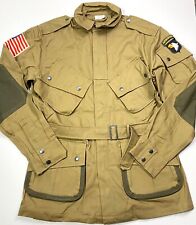
WWII US AIRBORNE PARATROOPER M1942 RIGGER REINFORCED JUMP JACKET- MEDIUM 40R $110.46

WWII US AIRBORNE PARATROOPER M1942 RIGGER REINFORCED JUMP JACKET-SMALL 38R $110.46
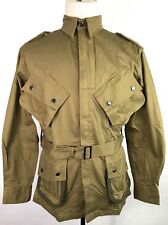
WWII US AIRBORNE PARATROOPER M1942 M42 REINFORCED JUMP JACKET- 3XLARGE 52R $80.71
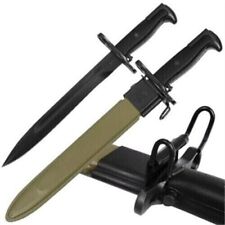
15" WWII US Army M1 Garand Bayonet Knife with Scabbard $44.99
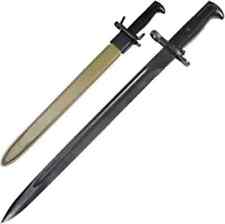
21.5" WWII US Army M1 Rifle Bayonet Knife with Scabbard $40.99
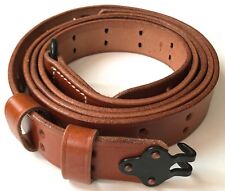
WWII US M1 GARAND RIFLE M1907 LEATHER CARRY SLING $25.46
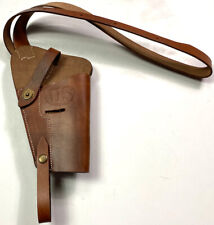
WWII US .45 PISTOL M3 SHOULDER HOLSTER-PRE-OILED $50.96
|